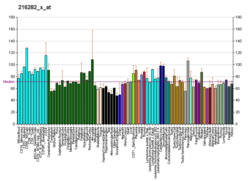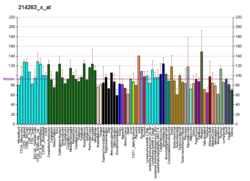POLR2C
DNA-directed RNA polymerase II subunit RPB3 is an enzyme that in humans is encoded by the POLR2C gene.[5]
Function
This gene encodes the third largest subunit of RNA polymerase II, the polymerase responsible for synthesizing messenger RNA in eukaryotes. The product of this gene contains a cysteine rich region and exists as a heterodimer with another polymerase subunit, POLR2J. These two subunits form a core subassembly unit of the polymerase. A pseudogene has been identified on chromosome 21.[6]
Interactions
POLR2C has been shown to interact with:
gollark: The predator drones randomly went rogue due to what seem to have been GPS issues (possibly me misunderstanding distance? not sure) and we lost most of them.
gollark: The predator drones have been shelved due to navigational issues, and the cartdrones have proven much more stable in initial testing.
gollark: It's one of GTech's experimental projects. I may have borrowed the idea and some of the code from Frogcat Industrial's research.
gollark: Both OC drones, and "cartdrone" technology.
gollark: Although they ARE a little unreliable.
References
- GRCh38: Ensembl release 89: ENSG00000102978 - Ensembl, May 2017
- GRCm38: Ensembl release 89: ENSMUSG00000031783 - Ensembl, May 2017
- "Human PubMed Reference:". National Center for Biotechnology Information, U.S. National Library of Medicine.
- "Mouse PubMed Reference:". National Center for Biotechnology Information, U.S. National Library of Medicine.
- Acker J, Mattei MG, Wintzerith M, Roeckel N, Depetris D, Vigneron M, Kedinger C (Aug 1994). "Chromosomal localization of human RNA polymerase II subunit genes". Genomics. 20 (3): 496–9. doi:10.1006/geno.1994.1208. PMID 8034326.
- "Entrez Gene: POLR2C polymerase (RNA) II (DNA directed) polypeptide C, 33kDa".
- De Angelis R, Iezzi S, Bruno T, Corbi N, Di Padova M, Floridi A, Fanciulli M, Passananti C (Jul 2003). "Functional interaction of the subunit 3 of RNA polymerase II (RPB3) with transcription factor-4 (ATF4)". FEBS Lett. 547 (1–3): 15–9. doi:10.1016/s0014-5793(03)00659-8. PMID 12860379.
- Corbi N, Bruno T, De Angelis R, Di Padova M, Libri V, Di Certo MG, Spinardi L, Floridi A, Fanciulli M, Passananti C (Sep 2005). "RNA polymerase II subunit 3 is retained in the cytoplasm by its interaction with HCR, the psoriasis vulgaris candidate gene product". J. Cell Sci. 118 (Pt 18): 4253–60. doi:10.1242/jcs.02545. PMID 16141233.
- Corbi N, Di Padova M, De Angelis R, Bruno T, Libri V, Iezzi S, Floridi A, Fanciulli M, Passananti C (Oct 2002). "The alpha-like RNA polymerase II core subunit 3 (RPB3) is involved in tissue-specific transcription and muscle differentiation via interaction with the myogenic factor myogenin". FASEB J. 16 (12): 1639–41. doi:10.1096/fj.02-0123fje. PMID 12207009.
- Acker J, de Graaff M, Cheynel I, Khazak V, Kedinger C, Vigneron M (Jul 1997). "Interactions between the human RNA polymerase II subunits". J. Biol. Chem. 272 (27): 16815–21. doi:10.1074/jbc.272.27.16815. PMID 9201987.
- Bertolotti A, Melot T, Acker J, Vigneron M, Delattre O, Tora L (Mar 1998). "EWS, but not EWS-FLI-1, is associated with both TFIID and RNA polymerase II: interactions between two members of the TET family, EWS and hTAFII68, and subunits of TFIID and RNA polymerase II complexes". Mol. Cell. Biol. 18 (3): 1489–97. doi:10.1128/mcb.18.3.1489. PMC 108863. PMID 9488465.
Further reading
- Jeang KT (1998). "Tat, Tat-associated kinase, and transcription". J. Biomed. Sci. 5 (1): 24–7. doi:10.1007/BF02253352. PMID 9570510.
- Yankulov K, Bentley D (1998). "Transcriptional control: Tat cofactors and transcriptional elongation". Curr. Biol. 8 (13): R447–9. doi:10.1016/S0960-9822(98)70289-1. PMID 9651670.
- Romano G, Kasten M, De Falco G, Micheli P, Khalili K, Giordano A (2000). "Regulatory functions of Cdk9 and of cyclin T1 in HIV tat transactivation pathway gene expression". J. Cell. Biochem. 75 (3): 357–68. doi:10.1002/(SICI)1097-4644(19991201)75:3<357::AID-JCB1>3.0.CO;2-K. PMID 10536359.
- Marcello A, Zoppé M, Giacca M (2002). "Multiple modes of transcriptional regulation by the HIV-1 Tat transactivator". IUBMB Life. 51 (3): 175–81. doi:10.1080/152165401753544241. PMID 11547919.
- Stevens M, De Clercq E, Balzarini J (2007). "The regulation of HIV-1 transcription: molecular targets for chemotherapeutic intervention". Med Res Rev. 26 (5): 595–625. doi:10.1002/med.20081. PMC 7168390. PMID 16838299.
- Harrich D, McMillan N, Munoz L, Apolloni A, Meredith L (2007). "Will diverse Tat interactions lead to novel antiretroviral drug targets?". Current Drug Targets. 7 (12): 1595–606. doi:10.2174/138945006779025338. PMID 17168834.
- Kato H, Sumimoto H, Pognonec P, Chen CH, Rosen CA, Roeder RG (1992). "HIV-1 Tat acts as a processivity factor in vitro in conjunction with cellular elongation factors". Genes Dev. 6 (4): 655–66. doi:10.1101/gad.6.4.655. PMID 1559613.
- Pati UK, Weissman SM (1990). "The amino acid sequence of the human RNA polymerase II 33-kDa subunit hRPB 33 is highly conserved among eukaryotes". J. Biol. Chem. 265 (15): 8400–3. PMID 2187864.
- Southgate C, Zapp ML, Green MR (1990). "Activation of transcription by HIV-1 Tat protein tethered to nascent RNA through another protein". Nature. 345 (6276): 640–2. Bibcode:1990Natur.345..640S. doi:10.1038/345640a0. PMID 2190099.
- Wu-Baer F, Sigman D, Gaynor RB (1995). "Specific binding of RNA polymerase II to the human immunodeficiency virus trans-activating region RNA is regulated by cellular cofactors and Tat". Proc. Natl. Acad. Sci. U.S.A. 92 (16): 7153–7. Bibcode:1995PNAS...92.7153W. doi:10.1073/pnas.92.16.7153. PMC 41297. PMID 7638159.
- Herrmann CH, Rice AP (1995). "Lentivirus Tat proteins specifically associate with a cellular protein kinase, TAK, that hyperphosphorylates the carboxyl-terminal domain of the large subunit of RNA polymerase II: candidate for a Tat cofactor". J. Virol. 69 (3): 1612–20. doi:10.1128/JVI.69.3.1612-1620.1995. PMC 188757. PMID 7853496.
- Keen NJ, Gait MJ, Karn J (1996). "Human immunodeficiency virus type-1 Tat is an integral component of the activated transcription-elongation complex". Proc. Natl. Acad. Sci. U.S.A. 93 (6): 2505–10. Bibcode:1996PNAS...93.2505K. doi:10.1073/pnas.93.6.2505. PMC 39827. PMID 8637904.
- Yang X, Herrmann CH, Rice AP (1996). "The human immunodeficiency virus Tat proteins specifically associate with TAK in vivo and require the carboxyl-terminal domain of RNA polymerase II for function". J. Virol. 70 (7): 4576–84. doi:10.1128/JVI.70.7.4576-4584.1996. PMC 190394. PMID 8676484.
- Agostini I, Navarro JM, Rey F, Bouhamdan M, Spire B, Vigne R, Sire J (1996). "The human immunodeficiency virus type 1 Vpr transactivator: cooperation with promoter-bound activator domains and binding to TFIIB". J. Mol. Biol. 261 (5): 599–606. doi:10.1006/jmbi.1996.0485. PMID 8800208.
- Zhou Q, Sharp PA (1996). "Tat-SF1: cofactor for stimulation of transcriptional elongation by HIV-1 Tat". Science. 274 (5287): 605–10. Bibcode:1996Sci...274..605Z. doi:10.1126/science.274.5287.605. PMID 8849451.
- Okamoto H, Sheline CT, Corden JL, Jones KA, Peterlin BM (1996). "Trans-activation by human immunodeficiency virus Tat protein requires the C-terminal domain of RNA polymerase II". Proc. Natl. Acad. Sci. U.S.A. 93 (21): 11575–9. Bibcode:1996PNAS...9311575O. doi:10.1073/pnas.93.21.11575. PMC 38099. PMID 8876177.
- Chun RF, Jeang KT (1996). "Requirements for RNA polymerase II carboxyl-terminal domain for activated transcription of human retroviruses human T-cell lymphotropic virus I and HIV-1". J. Biol. Chem. 271 (44): 27888–94. doi:10.1074/jbc.271.44.27888. PMID 8910388.
- Parada CA, Roeder RG (1996). "Enhanced processivity of RNA polymerase II triggered by Tat-induced phosphorylation of its carboxy-terminal domain". Nature. 384 (6607): 375–8. Bibcode:1996Natur.384..375P. doi:10.1038/384375a0. PMID 8934526.
- García-Martínez LF, Ivanov D, Gaynor RB (1997). "Association of Tat with purified HIV-1 and HIV-2 transcription preinitiation complexes". J. Biol. Chem. 272 (11): 6951–8. doi:10.1074/jbc.272.11.6951. PMID 9054383.
This article is issued from Wikipedia. The text is licensed under Creative Commons - Attribution - Sharealike. Additional terms may apply for the media files.






